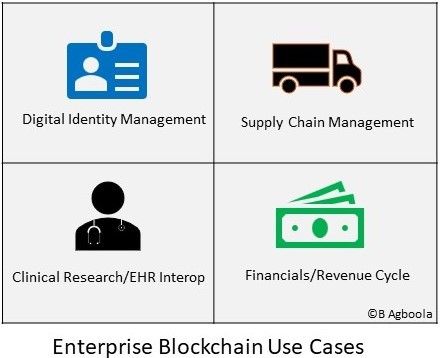Accelerating Your Enterprise Blockchain Adoption
By Bashir Agboola, VP/CTO, Hospital for Special Surgery
Since its introduction a little over a decade ago, there has been a mix of pessimism and measured enthusiasm about the prospects of the blockchain technology in the enterprise. Some business leaders continue to dismiss the blockchain, a decentralized time-stamped ledger of transactions that are written and cryptographically secured on a peer to peer network, as a passing fad, while an increasing number advocate for its enterprise adoption.
According to Deloitte’s 2020 Global Blockchain Survey, many business leaders list blockchain as a top-five strategic priority and increasingly commit resources to it. A growing majority of global enterprises (55%, up from 53% in 2019, and 43% in 2018), now view blockchain as an enterprise priority. Despite this uptick in commitment to the technology, 54% of leaders also feel that the technology is overhyped. This is not unusual, and perhaps signifies the cautious optimism that many leaders have developed around this technology.
Enterprise blockchain pilot projects and production implementations continue to emerge globally, with the most common use cases falling into these categories:

Digital Identity Management: Blockchain can be leveraged to address several challenges around identity management, including the effort to shift more of the control or ownership of identity data from identity providers to the individual owners of the identity. There are also ongoing projects to use blockchain to solve the problem of Provider Data Management in Healthcare.
Supply Chain Management: Blockchain can be used for real-time/multi-party tracking of goods, with an immutable audit trail. This has found application in Logistics and Retail (e.g., for product recalls) and in Pharmaceuticals (e.g., for drug traceability).
Financials: The Finance industry has been a leader in exploring the enterprise use of blockchain, and active pilot use cases include FX settlement in Banking. The Healthcare industry has also been exploring the use of blockchain to facilitate Revenue Cycle management.
Clinical Research/EHR Interoperability: Lifesciences and Healthcare also have interesting uses cases of blockchain, including managing patient consent in clinical trials, and tackling the longstanding problem of Electronic Health Records interoperability.
Despite the growing number of enterprise blockchain initiatives, a lot of obstacles remain in the path of enterprises seeking to adopt blockchain technologies. These include fundamental confusion around the nature of the technology. Many enterprises also struggle to identify viable business use-cases for the technology and to determine where blockchain offers better value than existing technologies. The lack of requisite technical skills has also made the exploration of the technology difficult. In addition, regulatory and technology standards that are required for the wide adoption of any technology are still evolving in the case of blockchain.
A Proven Path Forward
One proven approach to addressing the blockchain adoption challenges listed above is the use of a blockchain consortium to accelerate enterprise adoption. This is in some ways reflective of the success of other industry consortia in the evolution of nascent technologies (for example, the World Wide Web Consortium – W3C). A consortium membership allows an enterprise to leverage the collective technical skillsets of the consortium, as well as make for the distribution of the costs and risks associated with the development of the technology. It also facilitates the development of standards, key infrastructure and use cases, and partnerships for the purpose of the technology. It could also provide access to market intelligence. Blockchain consortia are private/permissioned and require membership to participate. This helps to mitigate some of the concerns around privacy and security associated with participating in public blockchains. Their focus defines the activities of blockchain consortia.
Business-focused blockchain consortia comprise of business entities with similar, complementary, or even competing business interests. This type of consortium is focused on developing blockchain use cases and standards for the adoption of the technology, and creating a partner ecosystem. Examples include the Synaptic Health Alliance, formed by some Healthcare Industry leaders to “explore the use of blockchain technology in tackling the challenge of accurate and efficient provider data management and sharing.” Another example is the IBM Food Trust, which connects “participants across the food supply through a permissioned, permanent, and shared record of food system data.”
Technology-focused blockchain consortia are focused on developing core blockchain technologies and related standards. The best-known example of this is Hyperledger, a global collaboration, “focused on developing a suite of stable frameworks, tools, and libraries for enterprise-grade blockchain deployments.”
Hybrid blockchain consortia, on the other hand, works to both develop the core technology as well as the business applications and uses cases for blockchain. An example is R3, founded in 2016 by several of the world’s leading banks. R3, now consisting of 300 participating global enterprises, has evolved into an enterprise software firm.
Today, there are dozens of global consortia, with participation by many of the leading global companies. Any organization wishing to explore the blockchain should consider whether joining a consortium would be beneficial to its efforts, as opposed to trying to go it alone in the beginning. They can start by identifying the blockchain consortia in their industry and assessing them based on the four success criteria described below to determine if joining a group could accelerate their learnings and adoption of blockchain technologies. An organization can also consider forming a new consortium in partnership with other enterprises.
The success and effectiveness of a consortium depend on a few key factors:
Governance: Having a well-defined and well-structured governance model is key to the success of any consortium. This helps define the role and participation of members, many of whom might be competitors.
Membership: The entities constituting the consortium defines what it can accomplish and how seriously it is taken by industry and regulatory authorities. Having key industry stalwarts in a consortium could grant it a lot of credibility and legitimacy out the gate.
Leadership: The leadership of the consortium can help set and drive its mission and vision and keep the organization on track. Leading consortia members often contribute significant intellectual property and technical capability to the consortium. Having reputable organizations in leadership roles on the consortium improves its chances of success.
Funding: Any viable consortia need a good source of funding for its activities. Having members that are financially committed to the mission of the consortium is critical to its success.
Blockchain is likely to become a strategic imperative in the coming years, and enterprise leaders are best served to position their organizations to learn and explore its potential benefit. Joining a consortium could be the easiest way for many organizations to achieve that goal.



